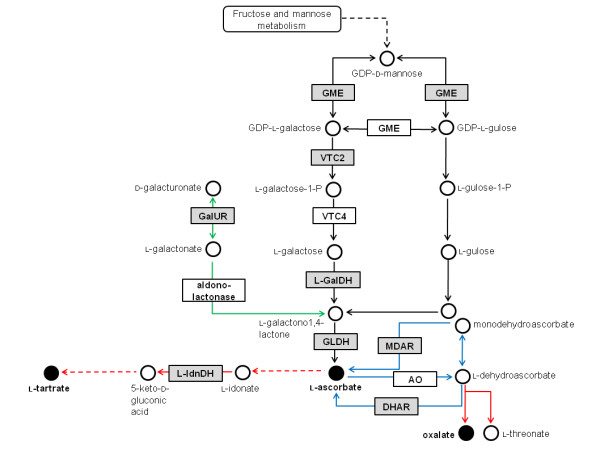Figure 1.

The proposed pathways of L-ascorbate (Asc) metabolism in plants. Single arrowed lines indicate one enzymatic step whilst dashed lines indicate multiple metabolic steps not shown in detail here. Black arrows represent steps in the primary Smirnoff-Wheeler Asc biosynthetic pathway, green arrows represent steps in the alternative 'carbon salvage' Asc biosynthetic pathway, blue arrows represent steps in Asc recycling and red arrows represent steps in Asc catabolism. Intermediates are represented by circles. Closed circles representing intermediates investigated in this study. The abbreviated names of enzymes catalysing individual steps are displayed in rectangular boxes. Shaded boxes highlight the genes encoding the enzymes investigated in this study. The Smirnoff-Wheeler primary Asc biosynthetic pathway enzymes include GDP-D-mannose-3,5-epimerase (GME), EC 5.1.3.18; GDP-L-galactose phosphorylase (VTC2), EC unassigned; L-galactose-1-phosphate phosphatase (VTC4), EC unassigned; L-galactose dehydrogenase (L-GalDH), EC unassigned; L-galactono-1,4-lactone dehydrogenase (GLDH), EC 1.3.2.3. The alternative Asc biosynthetic pathway enzymes include D-galacturonic acid reductase (GalUR), EC 1.1.1.203 and aldono-lactonase, EC 3.1.1-. Enzyme catalysed steps involved in recycling Asc include monodehydroascorbate reductase (MDAR), EC 1.6.5.4 and L-dehydroascorbate (DHAR), EC 1.8.5.1. C4/C5 cleavage of Asc in Vitaceous plants proceeds via the intermediates 2-keto-L-gulonic acid, L-idonic acid, 5-keto-D-gluconic acid, L-threo-tetruronate and L-tartrate. The only characterised enzyme of this pathway is L-idonate dehydrogenase (L-IdnDH), EC 1.1.1.264. C2/C3 cleavage of Asc or L-dehydroascorbate generates oxalate and L-threonate: this pathway may occur enzymatically or non-enzymatically.
